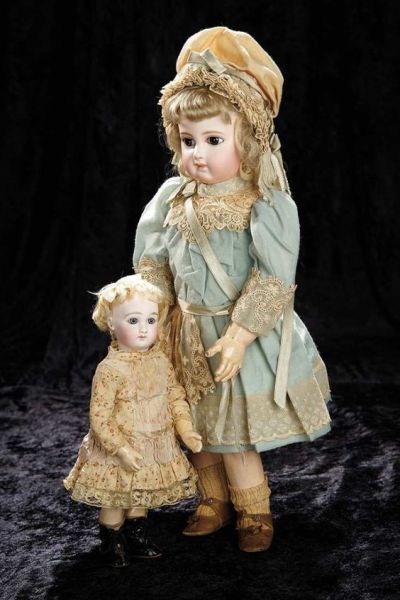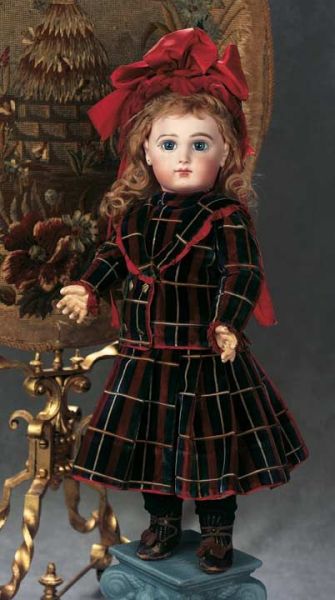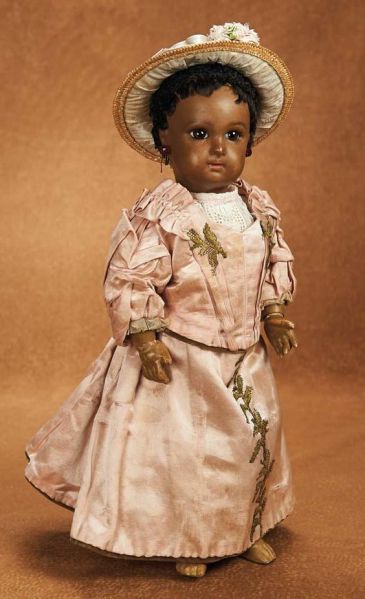(FYI for non-Francophones: Jumeaux is the plural of Jumeau.)
I’ve honestly never been much of a doll person. I never had nor wanted a Barbie, and always had more stuffed animals than dolls. I’m told I carried my few dolls under my arm like a football, instead of holding them close and cuddling them. I always gravitated towards gender-neutral toys, like marbles, or stereotypically “boy toys,” like miniature cars. None of the girly toys really appealed to me.
However, I always made an exception for collectible dolls, the kinds not meant for playing with. I love their clothes, hairstyles, faces, bodies, and accessories. The dolls I feature in my books tend to be homemade or generic toy store dolls, but I’ve created two Jumeaux recently. I think I found out about them when I got a Jumeau coffeetable book from a bargain table at Barnes and Noble.

The Jumeau company was founded by Pierre-François Jumeau and Louis-Desire Belton in the early 1840s, in Montreuil-sous-Bois (an eastern suburb of Paris). They quickly gained a name for themselves, and their beautiful porcelain dolls became very popular. In 1844, they presented their dolls at the Paris Exposition. When the Paris Exposition returned in 1849, the company earned a bronze medal. In the 1851 Great Exhibition in London, they earned a First Place Medal.
More accolades and awards followed. At the Exposition Universelle in Paris in 1867, the company earned a Silver Medal, and at the 1873 Vienna Exposition, they earned a gold medal. In 1878, they earned a Gold Medal at the Exposition Universelle, and proudly advertised this fact on the shoes, boxes, bodies, and clothes of their dolls.
At the Sydney International Exhibition of 1879 and the Melbourne International Exhibition of 1888, they won prizes as best dollmaker. In spite of all these awards, though, only a few pre-1870s Jumeaux can be definitively identified.

Jumeaux had become luxury, status symbols, and enjoyed their golden age from the late 1870s to the late 1890s. By 1877, Emile-Louis Jumeau (son of founder Pierre-François) had added Bébés to the company’s products. Bébé Jumeaux were made in the image of real little girls, with realistic glass eyes and beautiful, fashionable clothes.
The Jumeau star began fading when German dolls rose in popularity. German dolls were cheaper than French dolls, but equally well-made and belovèd by their owners. In 1899, the Jumeau company became part of the conglomerate Le Société Française de Fabrication de Bébés et Jouets. This consortium went under in the late 1950s.
Though Jumeaux are no longer made, they continue to be cherished collectors’ items.

One of my fictional Jumeaux is named Ambrózia, and belongs to little Ráhel Lívia Kovács. She was bought in a fancy Budapest toy store by Ráhel’s much-older sister Mirjam, a brilliant intellectual, academic, and hyperpolyglot. Ráhel receives her as a present in 1939, when she starts lighting candles upon her third birthday. Ráhel loves Ambrózia more than any of her other dolls, and takes her along to the Abony and Kecskemét ghettoes.
Ráhel is very worried when she remembers Ambrózia has a necklace that wasn’t turned over to the authorities or buried with the other valuables. She hid it under Ambrózia’s blouse since it’s Judaic jewelry. No one thinks a doll necklace could be worth much, but it’s a golden Magen David with diamonds and sapphires, inside a golden circle with more sapphires and diamonds, on a golden chain. Ráhel found the necklace at her maternal grandmother’s house after her death in 1942.

Ambrózia is tucked under Ráhel’s left arm as she and her 4-year-old baby brother Dániel run to safety while a few teenage boys on the death train raise a huge uproar at one of their many long stops. The outburst draws attention away from the escapees on the other side of the train. I got the idea for their escape from the 2006 German film Der Letzte Zug.
Ráhel and Dániel (who’s become very ill with diphtheria) find shelter at a nearby cloister of Esperantist Carmelite nuns. Originally they were murdered with most of the rest of their family, but I no longer had the heart to kill them after I started getting to know them.

In my fourth Russian historical, little Kaja Saara Lebedeva (radical Katrin’s firstborn grandchild) has a vintage Negro Jumeau from longtime family maid Mrs. Samson. Katrin’s family have always treated Mrs. Samson like an equal and friend, which often earns strange looks from people not used to the races mixing so closely. Likewise, Kaja doesn’t care her doll isn’t a mirror image of herself. To a child, a doll is a doll, whether white, brown, tan, or purple.
Jumeau first advertised mulatto and Black dolls in 1892.


I’m not much into dolls, but these are beautiful. My sister wasn’t that much into dolls either other than a brief interest in Barbies. We used to dismantle the dolls she received prior to her Barbie phase. I suppose if I had the money to spend and room to display them I might consider having a few dolls like these. Right now I have a Michael Jackson doll from the 80’s still in the original box and packed away in a storage trunk. Maybe it might be worth something someday, but probably nothing significant.
Arlee Bird
Tossing It Out
LikeLike
I always liked the display hammocks some people have for storing all their dolls or stuffed animals, though it would have to be securely fastened to the wall.
LikeLike
I loved Barbies and had two Cabbage Patch Dolls, but I also played with gender neutral toys and even boy toys. My two older sisters didn’t want to play with me, so I played with my brother. We played with cars and dump trucks, and rode our bikes around the block. I also played a lot of basketball. I only had one porcelain doll because it was a gift. My mom and sisters each had one, too. I thought they were so pretty and tried playing with them, but I was often made that I couldn’t really because they were breakable. lol
LikeLike
I also had two Cabbage Patch dolls. If they weren’t destroyed by mice in the attic, they went with my parents when they moved to South Carolina last October. I was always a fan of the more active toys, though I did enjoy playing pretend with stuffed animals and my few dolls.
LikeLike
Cool you were more of a tomboy.
Dolls like that are just a bit creepy to me, but that’s probably due to all of the horror films with dolls that I’ve seen.
How many do you own?
LikeLike
All my dolls went with my parents when they moved to South Carolina last October, though I think I have at least five porcelain dolls. It would be neat to someday learn how to make my own.
LikeLike
these dolls are gorgeous! i love the detail of their precious faces and beautiful, intricate clothes. and as usual, i learned a great deal and enjoyed it – thanks!
LikeLike
I’ve always had a thing for dolls!!!! I collected porcelain ones growing up. Love. And I love how much you know about history. I’ve missed your posts. Love your blog. Glad to be back in blogosphere. 🙂
LikeLike
Such incredibly stunning dolls! I love, but don’t (*really*) collect dolls myself either, though would likewise happily make an exception for these stunners. Thank you for shining the spotlight on this incredible brand.
Many hugs & sincere thanks for each of your wonderfully nice blog comments this summer (I wholeheartedly appreciate and enjoy them),
♥ Jessica
LikeLike